| The great
event that took place at
the Hackney and
which everyone looked
forward to when I was a
child was the yearly pantomime.
I am glad to see that the
Hackney Empire, in
its new incarnation,
still produces such a
production each year,
which I gather is popular
with locals and visitors
alike. The
pantomime was very
popular during the golden
age of Music Hall
and was presented at many
of the Empires on
the circuit in
December and part of
January. At that time, a
number of the West End
theatres also produced a pantomime.
The most famous of these,
although not strictly
a true pantomime, was
J.M. Barrie’s Peter
Pan, which was
presented each year at
the Scala Theatre
and later at other
theatres once that lovely
old theatre was
demolished to make way
for a building that the
populace of London could
easily have lived
without.
Children
and their parents looked
forward to the annual
visit to the panto, as
it was affectionately
known, and would not
dream of missing it.
Since those heady days,
the panto, like
all things, has been
subject to fashion and
fell out of favour for
many years. There were no
major productions in a
West End theatre for many
years until recently when
Kevin Spacey revived the art
at the Old Vic and
allowed Ian McKellen to
fulfill a life-long dream
by taking on the role of
one of the principals.
However, despite fashion
and changing tastes, panto
has refused to die
and productions continued
to be presented in
village halls and small
theatres throughout the
country. And now I note
that each Christmas time,
there are an increasing
number of productions
presented in the theatres
found throughout the suburbs
of London and in the provinces.
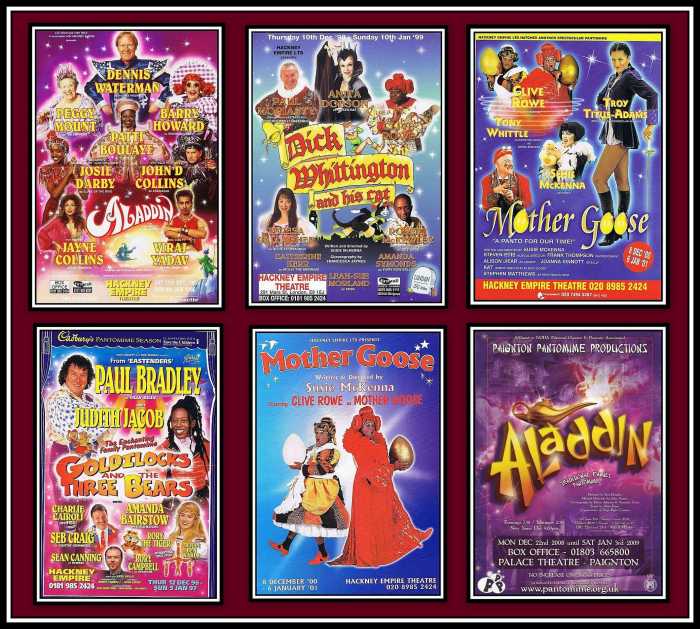
Click on
the posters to enlarge
them
The pantomime,
as it was and still
is presented in Britain,
is a peculiar affair. It
is something that is unique
to British theatre, and
hardly ever is presented
anywhere else. I find
this amazing since the
British colonized many
parts of the world, yet
Australia, New Zealand,
South Africa or Canada
produce few pantos.
None, as such, are
presented in the U.S. Panto
is a spectacle of song
and dance slotted into
the flimsiest of stories.
The story, such as
it is, would be based
either on a fairy
story – such as Mother
Goose, Cinderella,
Snow White, Aladdin,
Jack and the Beanstalk,
Puss in Boots etc
– or a nursery
rhyme – Little
Bo Beep, Humpty Dumpty
etc. The story
would be especially
written for the
production and would play
very much to the talents
of the principal players.
Now this is where
confusion comes in and
the cause of this
confusion comes from the
casting of the principal
characters.
All pantos
would have the same
basic principal
characters, each with
names suited to the
particular underlying story.
The main characters
were a principal boy,
a principal girl, a
dame, and a
villain, and
oftentimes, a fairy
Godmother. This would
seem simple enough, but
confusion would come with
the casting of the
principals.
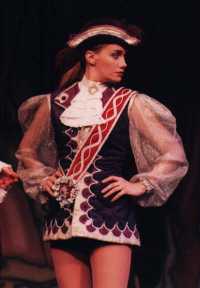 Firstly,
the principal boy,
who might be Aladdin,
Dick Whittington or
Prince Charming, would be
played by a girl. He
would always be dressed
in a short upper-body
outfit suitable to his
role, but no matter
what the plot, he
would always be in tights
so as to allow full view
of her shapely
legs. Secondly, there
would be an outrageously
dressed, overly made-up
and overweight woman,
who would be the mother
or stepmother of the principal
and was known as the
dame. She
would be both a source
and a figure of fun and
would be played by a man.
I have noticed that all cultures,
regardless of their
apparent differences,
seem to share one thing
in common: the women of
the society enjoy seeing
their men make fools of
themselves by dressing
as women. The
Japanese love it. The
English have a history of
it. And the Americans
have learned to accept
it. Playing the dame
in a panto was
considered to be a highlight
in the career of any
comedian of yesteryear
and many ordinary
erstwhile jokesters have
shone in this role. Some,
for example, Danny LaRue,
even made full-time
careers playing such
characters. Firstly,
the principal boy,
who might be Aladdin,
Dick Whittington or
Prince Charming, would be
played by a girl. He
would always be dressed
in a short upper-body
outfit suitable to his
role, but no matter
what the plot, he
would always be in tights
so as to allow full view
of her shapely
legs. Secondly, there
would be an outrageously
dressed, overly made-up
and overweight woman,
who would be the mother
or stepmother of the principal
and was known as the
dame. She
would be both a source
and a figure of fun and
would be played by a man.
I have noticed that all cultures,
regardless of their
apparent differences,
seem to share one thing
in common: the women of
the society enjoy seeing
their men make fools of
themselves by dressing
as women. The
Japanese love it. The
English have a history of
it. And the Americans
have learned to accept
it. Playing the dame
in a panto was
considered to be a highlight
in the career of any
comedian of yesteryear
and many ordinary
erstwhile jokesters have
shone in this role. Some,
for example, Danny LaRue,
even made full-time
careers playing such
characters. 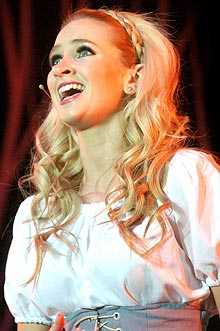 The
principal girl,
unless she was the title
character, such as
Cinderella or Snow White,
would generally be a minor
role, and would be played
by a girl. Imagine that!
The story would require
an antagonist or villain
who would be determined
to bring about the end
of the hero and would
be played by a man.
Lastly, there might be a fairy
Godmother that would
help the hero during his
or her time of greatest
need and would be played
by a woman. Now that is a
novelty! The
principal girl,
unless she was the title
character, such as
Cinderella or Snow White,
would generally be a minor
role, and would be played
by a girl. Imagine that!
The story would require
an antagonist or villain
who would be determined
to bring about the end
of the hero and would
be played by a man.
Lastly, there might be a fairy
Godmother that would
help the hero during his
or her time of greatest
need and would be played
by a woman. Now that is a
novelty!
The story
of most pantos
varied little from a
basic plan: the title
character would find
himself either wanting
something that was out of
reach – such as
a desperate desire to
attend a ball, or else be
yearning for riches to
feed a hungry family
– and would find his
or herself at the mercy
of some loathsome
creature – such as a
wicked stepmother,
which was most popular,
or by a character of myth
and fantasy such as the
King of the Rats, or
a wicked enchanter
etc. You get the picture!
Villains were important
to panto since
they generated crowd
response and, in
spite of their character,
were immensely popular
characters and vital to
the success of any
production. Their main
job would be to incite
the audience to
participate in the goings-on
on stage. For
example, they would
threaten the hero with
some foul torment and
then turn to the audience
and reinforce their plan
by adding Oh yes I am!
Such a threat and
declaration would cause
the audience to retaliate
by yelling Oh no
you’re not!
These remarks would pass
back and forth for a
while and the children
in the audience would get
very involved in the
rhetoric. My father would
enjoy such interactions
and would take part in it
with the gusto equal to
that of any child present
much to my mother’s chagrin.
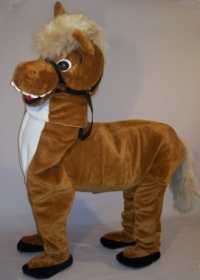 A
panto would not be
complete without a simple
but good-natured
companion for the principal
character. The
companion would be either
a servant or an animal
of sorts, which would
be played by one or two
actors depending on the
need. The animal would
most often be a horse
named Dobbin or a
cat imaginatively called Puss.
George M. Cohan, the
great American
vaudevillian and author
of many great songs,
remarked that when it
came to casting actors to
play a horse, one
always had difficulty
casting the front half!
This character, who would
be loved by the children
in the audience, had the
role of consoling the principal
at times when he or she
would be feeling
especially low and
convinced that he/she
would never overcome the
obstacles placed before him/her.
Often the animal or the
servant – or perhaps
a fairy Godmother
– would be
responsible for pointing
out something to the principal
who, quick as a flash,
would seize upon it and
come up with a plan of
escape from either a
prison, a cave or some
other cold, dark and damp
place where he/she
had been locked up to
whither away while the
villain or villains made
off to dance at the
ball or else claim
some treasure and the
princess. A
panto would not be
complete without a simple
but good-natured
companion for the principal
character. The
companion would be either
a servant or an animal
of sorts, which would
be played by one or two
actors depending on the
need. The animal would
most often be a horse
named Dobbin or a
cat imaginatively called Puss.
George M. Cohan, the
great American
vaudevillian and author
of many great songs,
remarked that when it
came to casting actors to
play a horse, one
always had difficulty
casting the front half!
This character, who would
be loved by the children
in the audience, had the
role of consoling the principal
at times when he or she
would be feeling
especially low and
convinced that he/she
would never overcome the
obstacles placed before him/her.
Often the animal or the
servant – or perhaps
a fairy Godmother
– would be
responsible for pointing
out something to the principal
who, quick as a flash,
would seize upon it and
come up with a plan of
escape from either a
prison, a cave or some
other cold, dark and damp
place where he/she
had been locked up to
whither away while the
villain or villains made
off to dance at the
ball or else claim
some treasure and the
princess.
Fortunately,
if the principal
character were a girl,
she would go to the
ball thanks to the
timely intervention of
her fairy Godmother and
meet Prince Charming and
perhaps lose a slipper
before eventually being
claimed by the prince as
his one true love. In
the case of the principal
being a boy, he
and his companion would
rush off and arrive in
the nick of time to
save the princess from
a fate worse than death,
which would generally
involve a sword fight
between the hero and
villain, which would
cause great excitement in
the children and my
father while watching
safely from their seats.
During such a battle,
there would be much
leaping over props and near
misses where all
would look lost for
the hero. Such grandiose
demonstrations of such
daring and skill would
bring loud and excited ooos
& aahs, as well
as well as appropriate
shouts of look out
or behind you from
the appreciative
audience. But eventually,
and to the delight of all
present, good would
always prevail and the
villain would be forced
to yield to the principal
boy and beg
forgiveness. After
promising to change
his ways, the villain
would be allowed to go
free. Once forgiveness
was given to the needy,
the principal boy
would claim the treasure
and the hand of the
princess would be thrown
in for good measure.
The panto
was a great event and my
mother would be sure to
purchase our seats almost
immediately tickets went
on sale. My mother was
especially particular
where we sat for the panto
and always wanted
tried to book Box J
for the second house on
Christmas Eve. Most
times, she was
successful, however there
were occasions when she
was forced to
accept another box,
generally just off-centre
or, God forbid, fort-tell
seats!!!
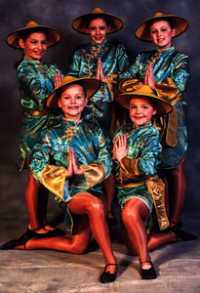 The
show would open in much
the same way as the
regular shows with a line
of chorus girls. They
would, of course, be
dressed according to the
story. My favourite panto,
I remember, was Aladdin.
Here the chorus girls
were dressed with coolie
hats on their heads
and in very short smocks.
Suitable make-up to their
eyes gave the impression
that they were oriental.
The costume for the
chorus girls was always
short and revealed their
legs for all to admire.
Sadly, feathers and
sequins and other items
of glitter were
not part of the general
chorus costume in a panto
- after all, it was a
production where parents
brought their children! The
show would open in much
the same way as the
regular shows with a line
of chorus girls. They
would, of course, be
dressed according to the
story. My favourite panto,
I remember, was Aladdin.
Here the chorus girls
were dressed with coolie
hats on their heads
and in very short smocks.
Suitable make-up to their
eyes gave the impression
that they were oriental.
The costume for the
chorus girls was always
short and revealed their
legs for all to admire.
Sadly, feathers and
sequins and other items
of glitter were
not part of the general
chorus costume in a panto
- after all, it was a
production where parents
brought their children!
Following
the dance, the dame
would make her
grand entrance. In Aladdin,
she was called the
widow Twang-Key and
was the mother of the principal
boy. Naturally the
children would laugh at
her exaggerated dress and
at the two large
balloons that were
stuffed into her costume
to simulate breasts and
the one behind to
accentuate her rear. Much
would be made during the
production to burst
these props. The dame’s
make-up would also be
outrageous. She would
have overly rouged cheeks
together with long and
very black eyelashes that
could be seen in the
balcony. The dame
would wear a wig of an
unusual colour and style.
In spite of the attire
and make-up, there was
never any mistake in
thinking that the
character was not a man
in disguise since little
was done to change the
voice. The dame would
generally appear 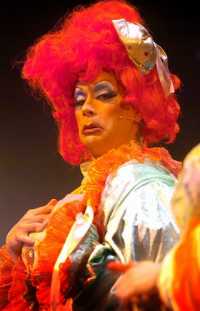 on
stage along with another
comic character that
would play the stooge
to the dame’s
jokes and tricks. The dame
would generally be played
by a well-known comedian
and so would be known to
the children in the
audience. on
stage along with another
comic character that
would play the stooge
to the dame’s
jokes and tricks. The dame
would generally be played
by a well-known comedian
and so would be known to
the children in the
audience.
Once the dame
made her entrance, she
would begin to yell and
complain about her son,
the principal boy.
The principal boy
would be seen as not
fulfilling his destiny
or else would be accused
of laziness and lacking
in ambition. Following
this, the dame
would call out in a loud
shrill voice for her good-for-nothing
son to come to her. The principal
boy’s entrance
would also invite much
clapping and cheering
since the children would know
that here was the
hero and that in spite of
what the dame
might say about him, she
loved him and that she
and the audience knew
that he would not
disappoint them in the
end. Nothing that
took place in a panto
was ever truly a surprise
to any member of the
audience unless they were
very young and this was
their first visit or if
they came from another
world, which generally
meant from anywhere
outside Britain.
The story
of the panto would
move along in fits and
starts as there would
still be many of the
usual Music Hall
acts that would now be
required to perform
before a backdrop
that doubled for The
Court of Emperor of China
or the palace where Prince
Charming lived. There
would be tumblers and
jugglers, again suitably
dressed according to the
story. Most importantly,
there would be a magician
since children loved
such performers. It was
the custom to invite
several 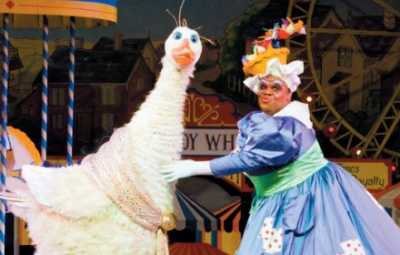 members
of the audience to join
the magician on stage
and help with the act.
The chosen
children always came from
the fauteuils,
much to the annoyance of
those that sat in the
circle and balcony, and the
chosen ones would
often be heartily booed
as they made their way to
the stage. Those not
chosen were convinced
that only rich kids sat
in the fauteuils
and so received
preferential treatment
and got to go on stage.
Despite this momentary
loss of good manners, the
jovial and festive mood
of the audience would
quickly return and
everyone would continue
to have fun and enjoy
themselves. members
of the audience to join
the magician on stage
and help with the act.
The chosen
children always came from
the fauteuils,
much to the annoyance of
those that sat in the
circle and balcony, and the
chosen ones would
often be heartily booed
as they made their way to
the stage. Those not
chosen were convinced
that only rich kids sat
in the fauteuils
and so received
preferential treatment
and got to go on stage.
Despite this momentary
loss of good manners, the
jovial and festive mood
of the audience would
quickly return and
everyone would continue
to have fun and enjoy
themselves.
Of all the
characters presented in a
panto, with the
possible exception of Dobbin,
I liked the villain best
of all. I always
enjoyed it when the he
was on stage. A favourite
name for a villain was Ebenezer,
obviously lifted
from Charles
Dickens’ Scrooge.
The best villain, as far
as I was 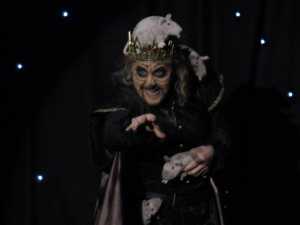 concerned,
was The King of the
Rats. The chorus
girls would double as his
subjects and everyone
would look most
provocative in elongated
ears, pointed
noses, long whiskers and
an exaggerated tail
that swayed to and fro as
they scampered
across the stage complete
with their permanent
smile. The villain
generally dressed in a
long billowing cloak
and would roar and
bluster about the stage
while making his threats,
which were meant to
frighten the children in
the audience. There would
always be some very young
children present who
would have to be carried
out of the auditorium
when the villain
became especially
outrageous in his
threats. Eventually the
villain would capture the
hero and would commit him
to being locked in a
cave or else tied
up in the hull of a ship
or left to rake out
the cinders.
Meanwhile the hero’s
torment would be added to
by the waving of thin
sheets to create the
effect of thunder
together with the dimming
and flashing of the stage
lights to simulate
lightning. concerned,
was The King of the
Rats. The chorus
girls would double as his
subjects and everyone
would look most
provocative in elongated
ears, pointed
noses, long whiskers and
an exaggerated tail
that swayed to and fro as
they scampered
across the stage complete
with their permanent
smile. The villain
generally dressed in a
long billowing cloak
and would roar and
bluster about the stage
while making his threats,
which were meant to
frighten the children in
the audience. There would
always be some very young
children present who
would have to be carried
out of the auditorium
when the villain
became especially
outrageous in his
threats. Eventually the
villain would capture the
hero and would commit him
to being locked in a
cave or else tied
up in the hull of a ship
or left to rake out
the cinders.
Meanwhile the hero’s
torment would be added to
by the waving of thin
sheets to create the
effect of thunder
together with the dimming
and flashing of the stage
lights to simulate
lightning.
Once the principal
boy was safely locked
up or tied up or given
monstrous duties to
perform, the villain
would take off to either
amuse himself by dancing
at the ball or by collecting
the treasure. Now,
with the hero
incarcerated and
seemingly without hope,
the curtain would be rung
down to announce that it
was time for the
interval. And so the
audience would be left to
wonder if he would be
able to escape a fate
worse than death.
The
interval would be spent
by most women and their
children forming lines
before the inadequate
number of toilets in the
theatre while the men
would crowd into the
bars. Meanwhile, ice
cream and sweets would be
purchased in huge
quantities from the
various salesladies
positioned about the
auditorium.
The second
half of the panto would
begin with a return of
the chorus followed by a
number of specialty acts.
During this half of the
show, the audience might
be treated to a star
attraction who
would perhaps have a role
in the panto.
Generally the star
would be a singer and
would be given time to
perform their act in regular
costume. I never
quite understood this break
in the story, but I
expect that such
performers helped ensure
the sale of tickets and
see that all seats were
filled at every
performance. The star
would sing some of the
songs that had made them famous,
as well as a number of
seasonal songs –
after all, it was
Christmas. Meanwhile, the
story would lumber on
until the final scene
when all would be well
following the speaking of
several lines by the
principals and thanks to
the intervention of the fairy
Godmother. The show
would end with everyone
coming on stage in the
reverse order of their
importance. Generally,
the principal
would present himself
for a final bow before
the dame. As a
child, I could never
quite understand this misrepresentation
and I would argue this
point with my parents
throughout the journey
home. After all I would
reason, the panto
was named for the principal
and not the dame, so
why shouldn’t he come
out for the finale
last of all? My parents,
I am sure tried hard to
give me a suitable
explanation for this insult
to the principal, but
I was never convinced and
eventually they left me
to ramble on merrily
about this travesty.
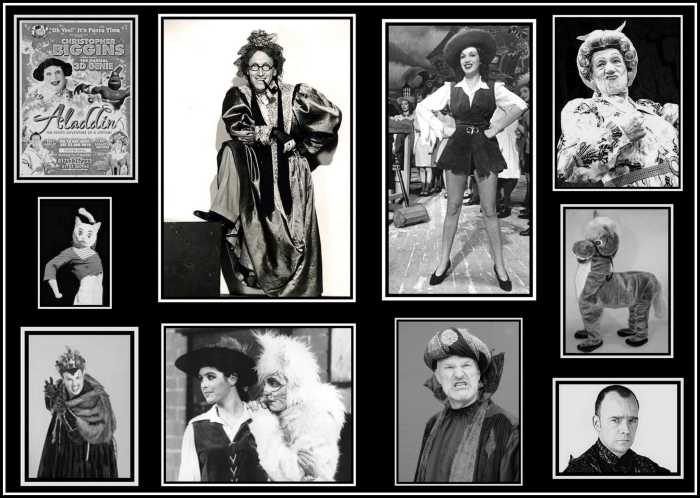
|